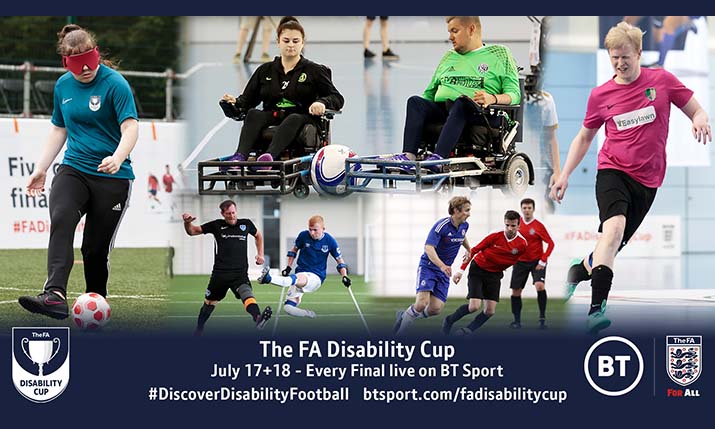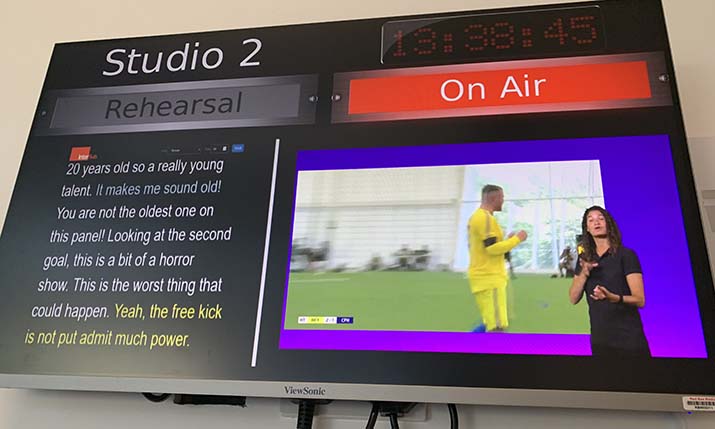FA Disability Cup brought to life for all by BT Sport in broadcasting first

BT Sport made the FA Disability Cup hit the records as being the most accessible live broadcast of a football match taking place in the UK to date
The FA Disability Cup was played at St George’s Park on Saturday 17 and Sunday 18 July, with BT Sport providing coverage over the weekend, the first time the Cup has been broadcast live.
This competition stood out from previous matches, not least because it made it onto our screens, but because it hit the records as being the most accessible live broadcast of a football match taking place in the UK to date.
On each day, live coverage of all the finals featured on three BT Sport channels with each offering different accessibility features, courtesy of Red Bee, a long time BT Sport partner.
“My ambition is to look at how we make these advances in technology and relationships with third parties, to long term make this just a standard offering. For me sport is always about a shared viewing experience, but all of these things enable you to watch as a group, but still cater for people who have different challenges”
BT Sport 3 showed enhanced Audio Description delivered by an expert based at St George’s Park, BT Sport Extra 1 showed British Sign Language, and with sub-titles were available on BT Sport 1. Meanwhile, BT Sport Ultimate provided coverage in up to 4K HDR picture quality.
Comments Jamie Hindhaugh, BT Sport’s chief operating officer: “I was so proud of what we did last weekend. Live subtitling and live signing have been around for a while, but bringing them together also with the audio description, and putting on three channels, that was a massive step forward.”

BT Sport worked with long-time partner, Red Bee to make the FA Disability Cup the most accessible broadcast to date
Complexity and cost
However, on why this level of accessibility for live sports is not done on a regular basis, Hindhaugh says it comes down to the complexities involved. He explains: “It’s a combination of complexity and the cost. So subtitle live subtitling is where the [accessibility] quotas are and for broadcasters, first and foremost it’s about meeting your quotas. [But also] that’s three different channels that we’re having to put content on and distribute across, so you’re in danger of tripling your distribution costs to do this on a regular basis. We’re looking at technology around how that becomes much more of [single] feed where people could select their own criteria,” he notes.
“Don’t misunderstand the opportunities around 4K, 8K and HDR, because that clarity of picture or that clarity of colours – that wider colour gamut – makes it easier to engage with”
Continues Hindhaugh: “We wanted to look at the impact of [making this more accessible for viewers] because it was almost an easy ask as it was the Disability Cup, and the content meant that there were a lot of people who were participating who wouldn’t feel included in the broadcast [otherwise]. But I think we’ve been on record for a long time that our ambition is to be truly inclusive so that all of our customers can engage and enjoy BT Sport.”
Next season, BT Sport will trial the inclusion of these accessibility features around other sports. “We’ve taken a lot of learnings from what we’ve done this [last] weekend,” continues Hindhaugh. “We will do at least one Premier League game and we will do a rugby game [in the same way].”

“The cornerstone for me on this is object-based broadcasting,” notes Hindhaugh. “So where all of these different elements are embedded in the stream and you can choose whether you want live subtitles or not”
More accessible broadcasts
BT Sport intends to roll out more accessible broadcasts overall going forward, adds Hindhaugh: “My ambition is to look at how we make these advances in technology and relationships with third parties, to long term make this just a standard offering. For me sport is always about a shared viewing experience, but all of these things enable you to watch as a group, but still cater for people who have different challenges.”
As to where this accessible coverage could end up, it will be part of BT Sports personalised offerings with a similar look and feel to how all viewers can currently watch and engage with BT Sport content.
“The cornerstone for me on this is object-based broadcasting,” notes Hindhaugh. “So where all of these different elements are embedded in the stream and you can choose whether you want live subtitles or not. We’re looking at things like avatars for signing. The audio description thing I think is really interesting; that was the most fascinating for me because it makes you realise there’s such a difference between TV commentary, radio commentary and then audio description.”
BT Sport is exploring more technologies to improve access to its content for sports fans. Hindhaugh says: “One of the things we are looking at is being able to fade up and down either commentary or background noise, because a lot of people do struggle with background noise around that clarity, and colour blindness as well is something we’re looking at.
“And don’t misunderstand the opportunities around 4K, 8K and HDR, because that clarity of picture or that clarity of colours – that wider colour gamut – makes it easier to engage with,” Hindhaugh continues. “So we’re looking at how we can combine those elements, but the things we definitely [are interested in pursuing are] alternative commentary, fading up and down, and also what we’re looking at with object-based broadcasting is to be able to make things like the score clock bigger or smaller, depending on your visibility needs.
“It’s really throwing it all up in the air and basically what you do is get all of those bits coming to you like a jigsaw that you can put together how you want them and how you need them, and you can set that up within your viewing experience so that’s your default. Personalisation to create a social viewing experience that is inclusive for all.”
How it was done
For the FA Disability Cup, live captions were first created by a Red Bee captioner re-speaking via Subito, Red Bee Media’s live captioning platform, while listening to a low latency audio feed of the broadcast. These captions were then reformatted through InterSub, a tool created by Red Bee to deliver real time transcripts in non-broadcast environments, and presented on the studio teleprompter used by the translator to provide sign language translation on screen.
Louise Seddon, Red Bee’s head of global access services operations at Red Bee, explains further: “Operationally what we did was take the live subtitles from the original channel on BT Sport 1, so the live subtitles are going out, they’re going to air, but we do a sort of internal simulcast; we grabbed them from Subito, which is our live inhouse subtitling platform, which we developed. The subtitles go to air but at the same time they are fed into a piece of technology called InterSub, which is also specific to Red Bee. InterSub is then rooted into our signing studios at broadcast centre.
“It presents a bit like an autocue, so the live subtitles come through as a sort of live autocue and our deaf translators are situated in the studios and they translate those live subtitles into British sign language,” says Seddon.
Working in this way presents opportunities for mistakes, but the team at Red Bee is experienced. Seddon notes on the Disability Cup: “The pressures and complexities are, I guess, kind of high risk. It’s high stakes because you’ve got the deaf translator live on air in front of a huge audience of thousands and thousands of people. And if the subtitles don’t come through, or if there’s a difficulty in the operational process, you’re really exposed because you’re effectively performing live.
“For this particular event, where you have a very long and continuous piece of output from 10:30am in the morning till 4.30pm in the afternoon, that’s a really long period of time to keep going on the live signing.
“But for the team these events are extremely exciting, because it’s a bit like being backstage at a theatre; you’re ready to perform and you’ve got the team around you and you pass over the baton of the coverage, but it’s also high stakes,” she concludes.
